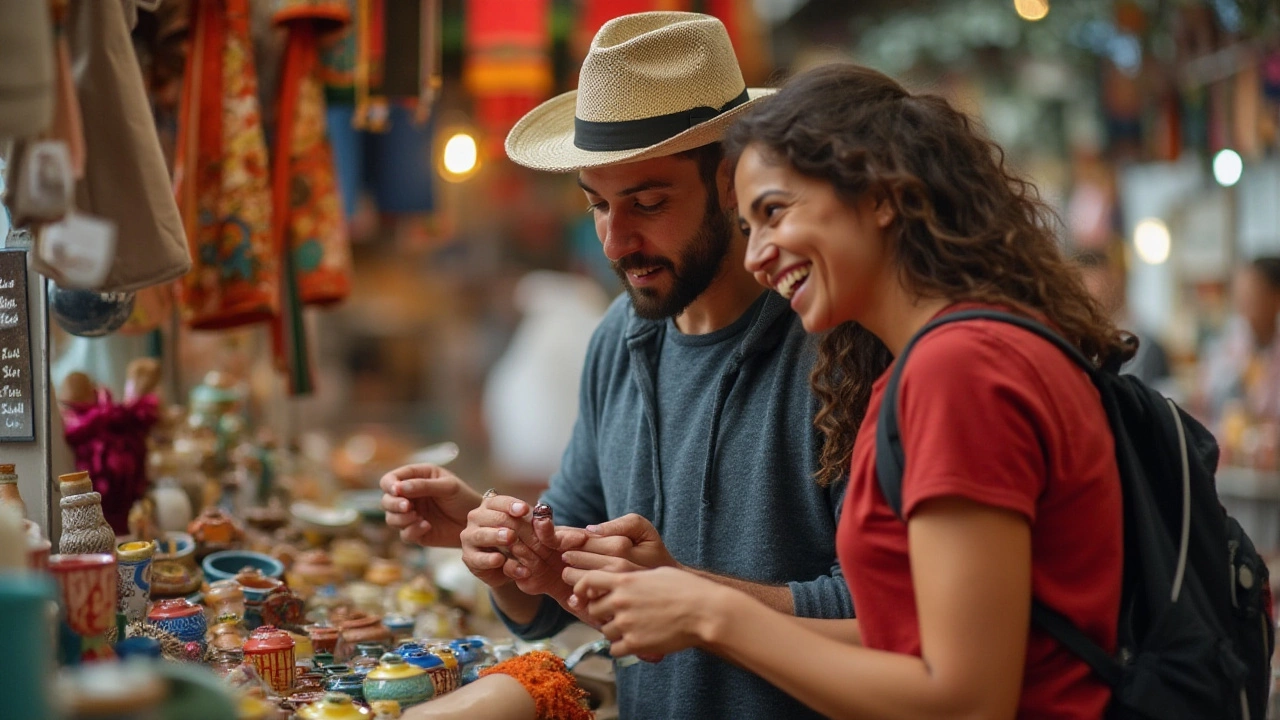Budgeting for a Two-Week All-Inclusive Mexican Vacation
 Jan, 2 2025
Jan, 2 2025
Ah, Mexico—the land of sun-soaked beaches, rich culture, and unforgettable cuisine. Planning a trip to indulge in all that this beautiful country has to offer can be thrilling. But figuring out how much money to bring for a delightful, worry-free experience requires a bit of planning.
Although staying at an all-inclusive resort covers most of the essentials like food and drinks, other costs can creep up on you. From the alluring street markets to those vibrant cultural shows, a clear budget can be your best travel companion. Let's walk you through what you need to bring and how you might spend it wisely.
- Understanding All-Inclusive Packages
- Essential Daily Expenses
- Extra Activities and Excursions
- Understanding the Local Currency
- Tips for Saving Money
Understanding All-Inclusive Packages
When dreaming of a vacation, the term "all-inclusive" can seem like magic words worth their weight in gold. Imagine stepping into a resort where your meals, drinks, and room expenses are wrapped into one neat package, seemingly freeing your wallet for two weeks from the usual vacation stressors. Yet, unpacking what an all-inclusive travel actually includes is the first step towards a savvy budgeting for your Mexican escape.
The standard all-inclusive package covers lodging, three meals a day at on-site restaurants, buffet-style dining, and usually some snacks throughout the day. Alcoholic and non-alcoholic beverages are also part of the deal, although the selection might vary. On top of this, many resorts cover entertainment such as nightly shows or access to pools and fitness centers. But don't get swept away just yet—think about how much you actually plan to leave the resort. Most packages won't cover excursions to nearby attractions, spa treatments, or specialty dining experiences outside the main offerings. Make sure you read through the fine print—misunderstandings can add unexpected weight to your budget.
Types of All-Inclusive Facilities
Diverse is the word. From sprawling family-friendly resorts teeming with activities for the kids to adults-only spaces where the quiet whispers of the ocean do the talking, choosing the right type matters greatly. Consider what resonates with you most. Some places offer basic packages while resorts with a premium tag tantalize you with more refined luxuries like private beachside dinners, and unless carefully checked, these extras come with extra costs. Mexico's Riviera Maya is renowned for such varied offerings where both budget travelers and those looking to splurge will discover a matching fit.
“Understanding what's included in an all-inclusive package is crucial. Not every resort offers the same benefits, some may surprise you with a la carte services,” says tourism expert Maria Cortez.
The local currency, the Mexican Peso, fluctuates in its exchange rate, which can affect the value you get from your trip if part of your all-inclusive deal features items priced in USD. Keep this in mind when considering the package price and what’s offered. There’s also an element of gratuity that often stays silent but should not be overlooked: tipping isn’t always included. It’s customary to tip service staff who go out of their way to make your stay extra special. Allocate a few pesos each day to reward excellent service.
| Included in Package | Possibly Additional |
|---|---|
| Lodging | Excursions |
| Meals and Snacks | Spa Treatments |
| Beverages | Specialty Dining |
| Basic Entertainment | Tips |
Ultimately, the first rule of happy all-inclusive travel is research. Know precisely what your package entails and get clarity upfront, especially if you’re inclined to explore outside the cozy confines of the resort. Once you know the bleeps and bloops of what’s covered and what’s not, you’ll be better poised to plan an awe-inspiring Mexican getaway. Empathy for your budget will go a long way towards enjoying the vibrant culture waiting just beyond the resort walls.
Essential Daily Expenses
When you're reveling in the sun-drenched paradise of a Mexican resort, it's easy to overlook certain daily expenses that can add up over a two-week stay. While your **all-inclusive travel** package might cover accommodations, meals, and drinks, you'll still encounter a few everyday costs that require budgeting. First off, consider tipping as a part of your daily expenses. Even in all-inclusive settings where gratuity is often included, a little appreciation for the hardworking staff goes a long way. It's customary to tip around 10-20 pesos per drink and a bit more at meals, depending on the service quality. These small amounts, while seemingly trivial, can accumulate, especially when spread across multiple days.
Transportation costs are another inevitable daily expense. Although many resorts provide shuttles for their guests, exploring beyond the resort boundaries can often be best achieved through local taxis or buses. A short taxi ride might set you back around 50-100 pesos, while buses are more economical at approximately 10-15 pesos per trip. Be sure to settle on a fare with the driver beforehand, particularly with taxis, to avoid any misunderstandings. If you're considering renting a car for a more autonomous exploration, ensure that you factor in gas prices, parking fees, and insurance coverage.
Souvenirs often become one of the heartwarming keepsakes from any trip, offering a tangible reminder of your time spent soaking in Mexican culture. From intricately handwoven textiles to colorful ceramics, the variety is immense. Prices can vary significantly based on the artisan's reputation and the intricacy of the item, but it's wise to set aside a daily allowance for these spontaneous purchases. An interesting aspect of shopping in Mexico is the art of haggling, particularly in open markets. Hone your bargaining skills and it can become both a fun and cost-saving activity.
The allure of local culinary delights could easily lead to venturing outside the buffet lines in your resort. Sampling street food is an adventure on its own; items like tacos, elotes, or churros are delicious yet budget-friendly, with most costing only a few pesos. A modest budget can allow for delightful daily indulgences in the flavors of authentic Mexican cuisine. As travel enthusiast Rick Steves aptly put it,
"Eating the local food isn't just about sustenance. It's about discovering how great meals can be experienced outside of fine dining rooms."
Travel expenses in Mexico are manageable with thoughtful pre-planning and attentiveness to daily spending. Though your resort covers many aspects of your stay, stepping out can lead you to many memorable experiences that don't have to break the bank. Enjoy your journey, and savor each experience with a discerning yet open mind.

Extra Activities and Excursions
When it comes to enriching your all-inclusive Mexican getaway, there’s a whole world of extra activities and excursions that can take your vacation experience from enjoyable to truly unforgettable. While your resort may offer some included adventures, consider branching out to explore more of what the local culture and landscapes provide. Picture yourself swimming in the crystal-clear cenotes, wandering through the ancient Mayan ruins, or even dancing to mariachi music on a moonlit beach. Each outing adds a new dimension to your adventure.
Many travelers find it essential to step beyond the resort to experience the authentic heart of Mexico. Activities outside the resort can vary widely in cost. For instance, a guided tour of Chichen Itza might set you back around $50 to $100, depending on group size and amenities. Meanwhile, if you're seeking a laid-back vibe, detailed beach yoga sessions or leisurely horseback rides on the coast could be alternatives worth exploring. Whether you aim for adrenaline through zip-lining or tranquility offered by a serene beach picnic, factor these adventure costs into your vacation budget.
Imagine snorkeling alongside vibrant marine life on a half-day excursion to Isla Mujeres or Cozumel—you'll likely encounter costs between $40 and $70 each. For those interested in deeper cultural experiences, a day trip to a traditional Mexican village could range from $30 to $60, where local guides share profound insights into their community’s customs and lifestyle. Keep your plans flexible yet researched to snag the best deals. According to a 2023 study by TravelPulse, “Tourists who plan and book excursions in advance save on average 20% compared to those who book on the spot.”
For the animal lovers out there, you might consider interactive adventures with Mexico's remarkable wildlife. At select sanctuaries, you can swim alongside gentle whale sharks or observe sea turtles nesting at protected beaches. These awe-inspiring moments, where nature and nurturing coexist, often carry price tags of $100 to $150. If you’re planning to include such ecological activities, ensure they are reputable and committed to wildlife preservation.
Don’t forget the casual yet delightful option of a culinary excursion. Dive deep into Mexico's culinary scene by attending a cooking class, where you'll learn to craft traditional dishes like tamales and salsa. These sessions not only give insight into local ingredients and cooking methods but also allow you to take a tasty piece of Mexico back home. Typically ranging from $60 to $100 per class, they’re a flavor-infused investment in your travel memories.
Here's a tip: Sometimes, resorts partner with local operators to offer discounted rates. Ask the concierge or activities desk at your resort for exclusive deals, but be sure to compare prices and read reviews online before committing. This way, you can ensure you’re not just getting a good deal, but also a high-quality experience.
As you plan, it might be helpful to list the activities that speak to you and arrange them by priority and cost. This allows you to align them with your budget, ensuring that when you're there, you’re spending both your time and money on what truly matters to you. Whether it's thrill-seeking exploits or quiet moments of connection with the local culture, each excursion outside your all-inclusive bubble adds texture to the tapestry of your Mexican journey.
Understanding the Local Currency
When planning a two-week journey to the heart and soul of Mexico, understanding the local currency, the Mexican Peso (MXN), is essential. The Peso has a storied history, tracing back centuries, and today it is an integral part of daily life in Mexico. Familiarizing yourself with its denominations is your first step to becoming a savvy traveler. Banknotes range from 20 to 1000 pesos, each adorned with notable figures like Frida Kahlo and Diego Rivera, and coins come in handy too, especially for small transactions at charming local markets and eateries. Though you might feel tempted to carry only cash, remember that a mix of cash and card transactions can offer flexibility and security, particularly as digital payments become commonplace in some areas.
Diving into exchange rates can feel like deciphering an enigma, but they're pivotal in your journey. Knowing how many pesos you receive per Canadian dollar is crucial to keeping your budget on track. Exchange rates fluctuate regularly, so keep an eye on financial news or reliable currency converters. As of late 2023, one Canadian dollar roughly equaled 16 pesos, but this rate can vary by day and location. To get the most out of your money, it's often wise to exchange some cash ahead of time, but leaving room for ATM withdrawals can also be beneficial given that many banks offer competitive rates.
Did you know that handling subtle differences in historical currencies adds richness to understanding Mexico's financial backdrop? An intriguing tidbit: prior to the 1993 monetary reform, 1,000 "old pesos" were equal to 1 "new peso." This reform streamlined accounting processes across the nation and ironed out a period of hyperinflation. Such reforms remind us that currencies are more than daily transactions; they are vessels of cultural and socio-economic histories.
"Currency exchange, much like language, is an indispensable part of travel. It's the medium through which we gain a deeper understanding of a country and its people." - Travel and Leisure Magazine
In bustling tourist hubs like Cancún or Mexico City, you'll find an ample number of currency exchange offices and banks, but rural areas may present challenges, making it practical to prepare beforehand. Using the local currency rather than USD avoids excessive conversion fees and shows respect to local businesses. When it comes to tipping—an essential custom in Mexico—small peso bills are invaluable, aiding you in leaving grateful gratuities in restaurants, for hotel staff, and during tours.
Keep an eye out for instances where businesses accept more than just pesos—the versatile nature of the Mexican economy sometimes permits payments through USD or CAD. Nevertheless, these alternatives should be reserved for rare occasions as peso transactions are typically smoother and more widely accepted. Always verify if your bank charges foreign transaction fees. A number of Canadian banks can offer accounts with zero to minimal fees for international withdrawals or purchases, which can benefit frequent travelers keen on exploring numerous Mexican vacation spots.
The dance between keeping cash on hand and utilizing cards requires striking a balance; credit cards or travel money cards from major providers are commonly accepted, especially in urban centers and tourist destinations. However, some off-the-beaten-path shops or eateries might prefer cash. To bolster trust and safety during these transactions, be certain to secure your belongings and use ATMs located in well-lit, reputable areas, or inside bank premises for added security.
Using the local currency while in Mexico adds layers to your experience and allows you to immerse yourself in the locale. It requires being attuned to shifts in exchange rates and planning ahead, especially if you plan to explore beyond your all-inclusive resort. With the right preparation, you’ll find securing the best value for your money a breeze, leaving you free to enjoy Mexico's natural beauty and diverse offerings without a hitch.

Tips for Saving Money
Heading off to a vibrant country like Mexico can be an exhilarating adventure, but no one wants to return home with empty pockets. There are multiple strategies to ensure your money stretches as far as your imagination during your all-inclusive vacation. First, consider whether you're getting the most out of your all-inclusive package. Often, these packages include more than just your meals and drinks—they might offer free access to fitness classes, introductory diving lessons, or cultural experiences like cooking classes and tequila tastings. Check with your resort for a list of all-inclusive amenities that are too easily overlooked.
Next, dining outside of your resort might be tempting, and you can absolutely try it but be aware of hidden costs that may arise. While exploring local eateries is a fantastic way to immerse yourself in the culture, make sure to research any restaurants and dishes beforehand to prevent unwanted surprises on the bill. Some resorts offer off-site dining experiences that are part of the package, so inquire if that's an option.
When it comes to getting around, plan your transport in advance. Rather than depending on taxis, which can quickly add up, consider local buses or even renting a bike if your location allows for it. Not only is this cheaper, but it's often a fun way to explore. Since the local buses are frequently used by residents, they provide authentic cultural experiences. However, always make sure to travel during safe times of day and stay in well-frequented areas.
Shopping undoubtedly forms a major part of any travel experience, especially in a place filled with colorful markets like Mexico. A great tip here is haggling, which is commonly accepted in these local markets. It’s not just about saving a few pesos but also about engaging with the local culture. Be polite and respectful, and you’ll often find the vendors open to negotiation.
Lastly, ensure you're well-acquainted with how tipping works in Mexico to avoid excessive spending. Though tips are usually included in the all-inclusive package, a little extra is often appreciated by the hardworking staff, which can sometimes grant you exceptional service in return. The suggested tip amount is usually 10-20% at restaurants, even when using the resort facilities.
"Tipping not only helps you build rapport with the locals but often elevates your experience," suggests the travel experts at Lonely Planet, a seasoned guide in helping travelers maximize their adventures without breaking the bank.
Now, let's take a look at a quick comparison of the local currency with the USD to help you manage your money better:
| Currency | Exchange Rate |
|---|---|
| 1 USD | Approximately 20 Mexican Pesos |
Keeping this rate in mind helps when you're calculating your daily spend. By employing these strategies, not only do you save significantly, but you often find yourself having deeper, more fulfilling interactions that money simply can't buy.
